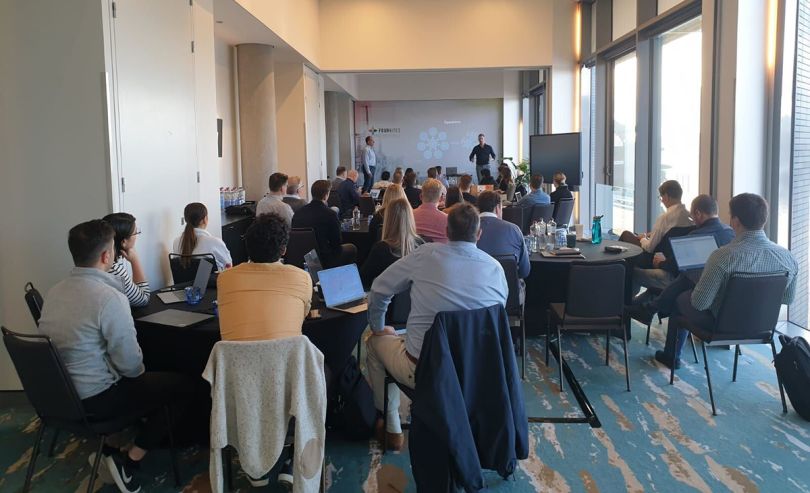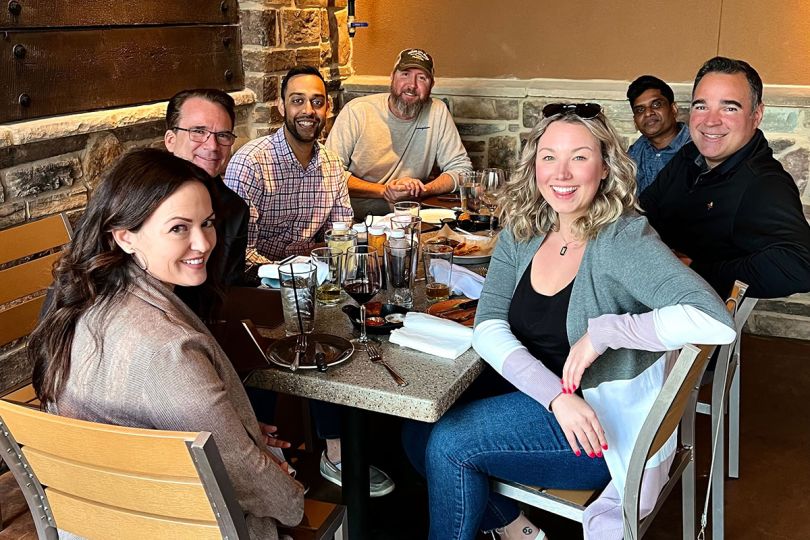As Russian troops invaded Ukraine earlier this year, prompting shock and consternation from leaders around the world, software architect Sadraque Viana watched on from Brazil. He and his colleagues at supply chain visibility company FourKites had seen it coming.
“At the borders around Ukraine, trucks were stopped,” Viana recalled.
In the weeks before war broke out, trade routes had been noticeably disrupted in the region, exacerbating the kinds of freight movement and port congestion issues that have plagued the global supply chain since Covid-19 erupted two years ago. At the Chicago-based company, which operates an advanced transportation visibility and analytics platform, employees could tell that something was wrong.
“It’s a different kind of realization for an engineer,” Viana said. “I have a view of how things truly are at a global scale.”
This big-picture perspective is key to FourKites’ business model. Catering to globally connected businesses, the company’s platform enables its clients to track shipments in real time across land, air and sea. The software’s machine learning capabilities even allow it to predict arrival times, and its recommendation engine flags shipments that could cause major bottlenecks so that companies can preempt them. Though there’s no accounting for human error or Mother Nature, widespread adoption of FourKites’ technology would have, for example, significantly reduced the logistical ripple effects of a 13,000-foot-long vessel becoming wedged in the Suez Canal last year. (It also, at the time, predicted the blockage before news outlets, according to Viana.)
By increasing the visibility of the global supply chain as a whole, FourKites seeks to lower operating costs for shippers, improve performance for carriers and keep shelves stocked for consumers. For its engineers, the benefit of FourKites’ platform became uniquely appreciable during the pandemic, even to the general public, as the platform worked to document, measure, resolve and even prevent supply chain disruptions throughout a fraught period of panic buying and page-one logjams.
Ian Jones, a principal software engineer, remembers riding the New York subway one day and overhearing a couple in conversation about the state of global trade. Soon after, he turned on the television and saw a FourKites colleague discussing the same subject with a morning news anchor.
“The supply chain field has such high visibility now,” Jones said. “It was always important, but its importance was not all that appreciated. Then, a big ship got stuck in the Suez Canal, and the pandemic happened. Companies and governments are needing to be smarter about it.”
At FourKites, Jones collaborates closely with other engineering team leaders, including Viana and Delbert Cope, the company’s chief technology officer, to tackle an evolving mixture of software engineering challenges and difficult computer science problems to support brands like Best Buy, Pfizer and 3M. The blend keeps things interesting for all three engineers, whose approach to supply chain orchestration is as creative and collaborative as such a globally relevant challenge demands.
“FourKites gives us this view of the world as interconnected,” Viana said. “Things have not historically been the most technology-driven in the global supply chain, but we’re working to make it even more robust.”

Engineers might not independently consider supply chain visibility as a specific problem space where their skills are needed. What have you learned about the roles engineers can play at a company like FourKites?
Delbert Cope, chief technology officer: We’re a supply chain company but, from the engineering perspective, we’re a data company. The supply chain space provides the problem we’re trying to solve, but we’re solving it with data. We understand what users want to get out of the platform and what value our customers are looking for.
We’re dealing deeply with data day in, day out. We’re using machine learning and statistical techniques to understand users and how they use the system. We’re setting up beautiful user interfaces (UIs) and solving hard computer science problems. With tons of data to display, how do we make our platform as efficient as possible on the front end? How do we make it scroll smoothly? How do we render all those little dots on a map that represent the entire view of your supply chain?
Ian Jones, principal software engineer: The problems are varied, and our engineering organization is big enough that people can find their respective homes. What really appeals to the engineers I interview is that we are working on something tangible. Engineers are often set up in jobs across ad tech, ad insertion, finance or venture capital, where they’re working on a phone app that’s just like another social network. This is something different.
Sadraque Viana, software architect: One of the main reasons that inflation is an issue right now has to do with supply chains. We’re working on improving supply chains; especially since the pandemic forced everyone to stay home and rely on shipping, FourKites is directly impacting people’s day-to-day lives more than ever before.
Engineers, however, know that we live in a very messy world; it’s not like data is sitting there, and we’re just gathering it to display nicely. It’s hard to do what we do, which is why we need talented engineers to join us. Our engineering team is also fully remote. That was a strength throughout the pandemic, but it also enables us to work with people all around the world. I live in Brazil, but the company being remote makes it possible for me to work here.
Coming into the supply chain space to create visibility and modernize freight, what are some of the more surprising problems you have to solve?
Cope: The most surprising thing, for me, was just how incomplete supply chain data is in general. It hasn’t been modernized. You’re oftentimes still talking about standards that were set up in the ’70s. The core supply chain data out there for us to ingest is of pretty poor quality. When onboarding a carrier, we need to get their data. But, in the supply-chain field, companies are still using many data technologies that are outdated. File Transfer Protocol (FTP) has died out across the world as a data transfer mechanism. But we still have to support it, because it’s how a lot of carriers send data.
We also came into the supply chain space just before the pandemic hit. Most of us did not think about the supply chain before all this craziness happened. You went into the store, you bought what you wanted, and the shelves were always stocked. You never had to think about where it was coming from. Then, the pandemic happened. We’ve found ourselves in a field that impacts people’s lives in a very direct way. We’ll help ensure that, for instance, baby formula is available on the shelves. And if it’s not, we’ll find out what’s tying it up, alert people and get goods where they need to go. It’s cool and surprising at the same time; being in the driver’s seat for technology that has the chance to change so many lives at this particular point in time.
Viana: It’s striking to realize I’m working on something global in scale. It’s the first time in my life that I’ve had this experience. How do you handle dates and time zones? You figure it’d be simple, but there are a million different ways to handle dates in all the programming languages that exist. And we still find ourselves in difficult situations, because there are ships crossing meridians all the time. You work with all kinds of carriers: big ones, with integrations that are easy to use, and mom-and-pop shops with one truck that, in specific use cases, we still have to support.
In your day-to-day work life, what technologies do you use at FourKites?
Viana: We’re using TypeScript, React, Python and FastAPI for services, as our bread and butter, as well as Apache Kafka for data science, and programs such as Native and Flutter. You have the opportunity to work with some of the most modern stacks out there, but there are also some pieces like Moodle and Java for Enterprise software. We still need to support older technologies, because that’s what still runs the supply chain in places. As a new engineer, you have your pick of what you like working with the most.
Jones: There’s a lot to do along the whole spectrum, from front-end architecture to middle-layer with FastAPI, data-message-bus warehousing, machine learning, data analysis, logging and reliability. We are flexible enough as a company to try to get engineers interested without boxing them in too much. If you have some front-end interests, there’s front-end work to go around. If you have API-level interests, you could spend time doing API, both architecture and implementation. If you want to do analysis or visualization, there’s work to do there. Wherever your interests lie now, and also wherever you think they might develop in the future, there’s opportunity at the company. I think we all agree that it’s a pretty exciting data set and stack to explore. We try to be as modern as possible, but there are things inherent in the domain that are not super-modern. We’re certainly doing our best to pull everything forward.

How would you describe the culture at FourKites?
Cope: People are willing to entertain just about any idea or approach to solving a problem. We’re open to innovation as part of the culture here, which is awesome, because our tech stack evolves. Technology changes so quickly. It’s about seeing what’s available, getting creative and solving problems in the most efficient way possible. Your voice will be heard. I’m a big believer in the idea that, if you’re the smartest person in the room, you’re in the wrong room. I trust the people on my teams to solve problems.
Jones: One of our colleagues has set up a curriculum to start teaching a part of our tech stack that’s often neglected. A number of engineers who are looking to expand their horizons have attended, and the curriculum is also available for anybody who comes along. That was organic; it wasn’t necessarily a top-down decision. As engineers, we wanted to figure out what would make this organization better and grow everybody’s skills. Certainly, in today’s hiring environment, it makes a lot of sense to develop internally as much as you can. Obviously, hiring is still going to happen, but I think developing internal talent is a secret weapon.
Cope: There are tons of opportunities to find mentorship and get to work on interesting problems. It’s a remote-first environment for how we develop, so people ask questions and jump into problems, often in a very cross-functional manner. At FourKites, teams do not operate in siloes. For employee growth, that provides a lot more than if you were stuck on a static team that’s working on the same stuff over and over again. You get the exposure of what everybody else is working on, you can hop in and help, you can learn, and you can then jump to doing something else different. Maybe you’re a QA engineer, and you start digging into development; maybe you’re a QA engineer but are more interested in the program management piece of it. That’s an opportunity that’s there. And at FourKites, you’ll find enough mentorship and enough willingness in the company to push you up.
Viana: Are you familiar with the word ‘adhocracy?’ It’s a way of organizing a company that gives us engineers the freedom to organize ourselves. We’re centered around what the problems are and coming up with ways to solve them. As long as we’re committed to solving problems, we’re given freedom. You’re not tied to what your leader expects. You’re tied to what you expect of yourself and what you can provide.







